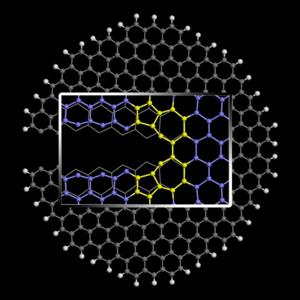Jan 27 2015
Theoretical physicists at Rice University are living on the edge as they study the astounding properties of graphene. In a new study, they figure out how researchers can fracture graphene nanoribbons to get the edges they need for applications.
 Graphene nanoribbons can be enticed to form favorable "reconstructed" edges by pulling them apart with the right force and at the right temperature, according to researchers at Rice University. The illustration shows the crack at the edge that begins the formation of five- and seven-atom pair under the right conditions. Credit: ZiAng Zhang/Rice University
Graphene nanoribbons can be enticed to form favorable "reconstructed" edges by pulling them apart with the right force and at the right temperature, according to researchers at Rice University. The illustration shows the crack at the edge that begins the formation of five- and seven-atom pair under the right conditions. Credit: ZiAng Zhang/Rice University
New research by Rice physicist Boris Yakobson and his colleagues shows it should be possible to control the edge properties of graphene nanoribbons by controlling the conditions under which the nanoribbons are pulled apart.
The way atoms line up along the edge of a ribbon of graphene -- the atom-thick form of carbon -- controls whether it's metallic or semiconducting. Current passes through metallic graphene unhindered, but semiconductors allow a measure of control over those electrons.
Since modern electronics are all about control, semiconducting graphene (and semiconducting two-dimensional materials in general) are of great interest to scientists and industry working to shrink electronics for applications.
In the work, which appeared this month in the Royal Society of Chemistry journal Nanoscale, the Rice team used sophisticated computer modeling to show it's possible to rip nanoribbons and get graphene with either pristine zigzag edges or what are called reconstructed zigzags.
Perfect graphene looks like chicken wire, with each six-atom unit forming a hexagon. The edges of pristine zigzags look like this: /\/\/\/\/\/\/\/\. Turning the hexagons 30 degrees makes the edges "armchairs," with flat tops and bottoms held together by the diagonals. The electronic properties of the edges are known to vary from metallic to semiconducting, depending on the ribbon's width.
"Reconstructed" refers to the process by which atoms in graphene are enticed to shift around to form connected rings of five and seven atoms. The Rice calculations determined reconstructed zigzags are the most stable, a desirable quality for manufacturers.
All that is great, but one still has to know how to make them.
"Making graphene-based nano devices by mechanical fracture sounds attractive, but it wouldn't make sense until we know how to get the right types of edges -- and now we do," said ZiAng Zhang, a Rice graduate student and the paper's lead author.
Yakobson, Zhang and Rice postdoctoral researcher Alex Kutana used density functional theory, a computational method to analyze the energetic input of every atom in a model system, to learn how thermodynamic and mechanical forces would accomplish the goal.
Their study revealed that heating graphene to 1,000 kelvins and applying a low but steady force along one axis will crack it in such a way that fully reconstructed 5-7 rings will form and define the new edges. Conversely, fracturing graphene with low heat and high force is more likely to lead to pristine zigzags.
Source: http://www.rice.edu/